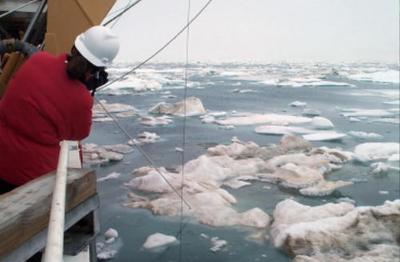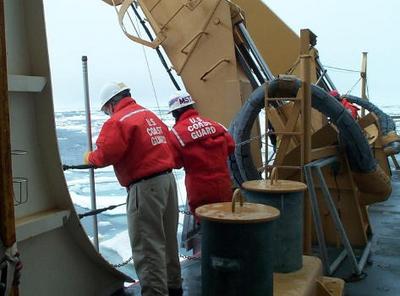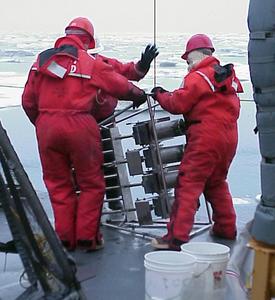
|
|
24 July, 2002
I know Iíve mentioned the perils of science at sea
more than once, but Iím going to do it again.
Throughout the day today we saw one example after
another of how difficult it can be to do science at
sea, parcticularly in the Arctic. Once again I started
my day at midnight when we got ready to send down the
van Veen grabs. Four of the five went well, but one
came up with the winch wire wrapped around the buckets
and we had to send it down again. Ordinarily that
takes only a matter of minutes, but we were in Barrow
Canyon at 450 meters (remember that a meter is a
little more than a yard), and each time we put down
the van Veen we had to wait at least a half hour for
it to go down and back. As we get even deeper, the
times will increase substantially. The grab probably
got twisted because we were on the steep slope of the
canyon. That same steep slope was most likely the
cause of the nearly upside down Haps core that came
up. (Check out the picture below.) It too had become
twisted in the wire. Although it contained four
sediment cores, they were unusable since it is
critical that a sediment core provide an accurate
sample of the layers at the bottom and mixing had
occurred when it got twisted. The second core
provided excellent results, and we were able to
complete our work just in time for breakfast at 7 AM.
It was a cold night and we had a light drizzle for
most of our time on deck. We came inside every chance
we had to try to get warm and to catch some sleep.
You can see how easily Jackie fell asleep in the
picture below.
By the time we finished our work, we were nearly to
the next station. Thatís when the real problems
started. When we are in open water or even in full
ice, itís always easier to send down equipment. Today
the ice was in huge blocks all around us. The groups
studying zooplankton were able to put their MOCNESS
(see my journal of July 18 for a picture and
description) into the water as the MST (marine science
technician) used a long pole to push the ice away.
The problems came when they were towing it and it got
trapped under the ice. After 45 tension-filled
minutes, the MOCNESS was safely back on board. Itís a
very valuable piece of equipment, and it could easily
have been seriously damaged or even lost.
Problems started again soon after the recovery of the
MOCNESS. You might remember that, at the beginning of
each station, the team of science technicians sends
down a service cast to collect water. Like the
MOCNESS this rosette of 12 Niskin bottles and the CTD
is a delicate and valuable piece of equipment.
Despite all their best efforts, they simply could not
move the ice enough to get the rosette of bottles into
the water. At that point, the chief scientist made
the decision to abandon this site. He felt that we
were simply not going to be able to safely complete
the work the scientists needed to do. During the
spring SBI cruise, they were unable to complete some
stations due to the heavy ice pack. The Healy is
designed for work in the Arctic, but even its advanced
technology and capability to work in ice are not
always enough when Mother Nature decides to step in!
After dinner each science team reported on their
current work and the results they had obtained during
the 40 day spring cruise. Itís fascinating to hear
about each individual project, but itís also
interesting to see how they all fit together.
Chemistry, physics, biology, geology and ice dynamics
(from the spring cruise) are all a part of this huge,
multi-year project. Historically there has not been
extensive research done in the Arctic Ocean. When all
the data from this project are analyzed and all the
pieces are put together, the SBI project will provide
a picture of what is happening throughout the western
Arctic Ocean. Hopefully it will also provide a better
understanding of global climate change and its
potential impact.

While waiting for the Haps core to come up again, Jackie catches a little sleep. She's working so many hours each day that she's happy to get these extra few minutes.

This is the ice that caused all the problems. No matter how hard they tried, they could not keep it away from the CTD cast. Despite everyone's best efforts, we did not complete the station. Note: this picture was taken by Ev Sherr, one of the scientists on board.

This was the beginning of the CTD service cast that had so many problems. Note the pole being used to try to push the ice away. This picture was taken by Ev Sherr, one of the scientists on board.

Jackie is pretty sure that the reason for our nearly upside down Haps core was that it came down on the steep Barrow canyon wall and was flipped. Needless to say we didn't use the samples from this core!
Contact the TEA in the field at
.
If you cannot connect through your browser, copy the
TEA's e-mail address in the "To:" line of
your favorite e-mail package.
|
